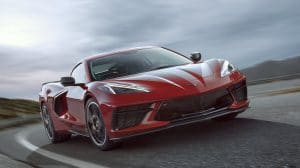
The 2020 Chevrolet Corvette Stingray offers impressive performance matched to stunning comfort — it could be your everyday driver.
It’s one thing to see a new car sitting up on a podium, like some piece of artwork, another to have it down in a parking lot, especially when it’s lined up alongside a couple dozen other all-new 2020 models. The first time I saw the new “C8” Corvette Stingray was up on stage at the big debut event Chevrolet set up in California back in July. The second time was at the staging ground for the annual comparison test drive run by the North American Car, Truck and Utility Vehicle, or NACTOY, jury in Ann Arbor, Michigan, last week.
If anything, the 2020 Chevrolet Corvette seemed more formidable lined up there, passersby stopping to gaze and gawk. If I expected to be a little more jaded this second time around, I was wrong. I was as awestruck by the first-ever mid-engine ‘Vette as I had been over the summer. The one big difference? This time I had the key to the cherry-red sports car, and a route all picked out.
Sliding into the car’s embracing driver’s seat, I tapped the start button and was rewarded by a deep, resonant thrum from the C8’s LT2 small block V-8. At the suggestion of my co-pilot, a senior Corvette team engineer, I twisted the mode dial to “Comfort,” and shifted into gear, pulling out of my parking spot and onto Jackson Road.
(This Changes Everything — or So GM Promises with New 2020 Corvette Stingray)
The 2020 Stingray’s 6.2-liter V-8 now punches out 495 horsepower, 40 more than the 2019 C7 edition, while torque rises 10 pound-feet, to 470. But unlike muscle cars of the past, the C8 is surprisingly well-mannered, especially set to Comfort. Merging into traffic, it maintained a pleasant poise, no jerkiness as I tapped the throttle coming off a stoplight.
What you quickly discover is that the new Corvette has no problem being used as an everyday driver. Even on the rough pavement that is a Michigan norm, its magnetic ride control system – more on that later – soaks up all but the worst bumps. And since you sit closer to the nose, thanks to the mid-engine layout, you get a better feel for your surroundings, especially when weaving in and out of traffic.
As we finally reached our turn off, I gave the driver’s mode switch another turn, setting us into “Sport.” That simple maneuver immediately adjusted an array of vehicle settings, including steering assist, throttle responsiveness, the stiffness of the suspension and transmission shifts. As the road opened up and I stomped on the throttle, it was like unleashing bottled lightning.
While we didn’t have the opportunity to run a clock on our launches, there’s no reason to doubt Chevy’s claim that the 2020 Stingray can launch from 0 to 60 in “less than three seconds.” Even without engaging the built-in Launch Control system, I found myself sinking deep into the driver’s seat, my sense of acceleration further rewarded by the LT2’s roar – further amplified when you’re in Sport or Track mode.
The numbers are impressive when you consider the Stingray out-accelerates last year’s Z06 and comes within a couple tenths of a second of the 0-60 times quoted for the current ZR1, despite having 260 fewer ponies.
Somewhat surprisingly, with a wheelbase of 107.2 and a nose-to-tail length of 182.3 inches, with it sitting 76.1 inches at its widest, the new model is actually longer, wider than the C7. And, at 3,666 pounds, it is 366 pounds heavier. On a power-to-weight ratio, it’s hard to figure out how it does so well.
A variety of factors contribute to the new car’s performance, starting with the relocated engine which puts a lot more mass over the back, driven wheels, especially during launch. You’ll have to work a lot harder to break traction and smoke the tires with the new C8.
Then there’s the new, eight-speed double-clutch transmission. Sure, some folks are disappointed not to have a stick. I am an inaugural member of the “Save the Manual” club, but after spending time in the 2020 Corvette, I don’t think I’d have it any other way.
A lengthy conversation with Chief Engineer Tadge Juechter could persuade almost anyone, in fact. But to keep things short: opting for a mid-engine layout with a rear transaxle makes it cleaner and simpler to go with a manumatic gearbox. The eight-speed DCT is also blindingly fast, taking as little as around 100 milliseconds to shift
gears. Meanwhile, other than during Launch Control and in Track Mode, shifts are virtually imperceptible.
You might not know when a gear is changed but for the change in engine note. And, of course, if you really prefer choosing your own gear there are the requisite paddle-shifters.
(A C8 Corvette Q&A with GM President Mark Reuss)
During my relatively short first drive I didn’t get the opportunity to push the C8 anywhere near its limits, especially in turns of steering and handling. Initial impressions are solid, with just the right level of road feel, a clear sense of being on-center, and an uncanny grip, even in a high-speed turn. For those who want a little extra fun, the new Corvette does allow you to hang out the rear end a bit, as we pleasantly discovered going into a highway on-ramp at significantly extra-legal speed. But it remained completely predictable and confidence inspiring.
Another factor that helps boost performance and handling is the aforementioned magnetic ride control system. As the name implies, it relies on dampers using a magnetorheological fluid. That’s a fancy way of saying an oil containing nano-sized magnetic particles. Applying a current inside the damper can change the viscosity from super-soft to ultra-firm – or any setting in-between – in the time it takes the car to travel 2 inches at 60 mph. And each corner can have a different setting. Go into a fast corner, for example, and the outer dampers will be set stiffer to minimize body roll.
I should also mention that our test car was equipped with the Z51 package that included Michelin Pilot Sport 4S tires. For those that want to push the new car to its limits, that’s a must. Just remember these are summer tires and be prepared to change them out when the weather retreats in Northern climes.
When you consider the $58,990 base price of the Corvette – before delivery fees and the word, “bargain” immediately comes to mind. From a performance standpoint, you’re getting nearly all you could expect out of the outgoing ZR1 for barely half the price. Adding in the Z51 package and other options can push you into mid-$80,000 territory. Even then, once we get a chance to calculate hard performance numbers, we expect the 2020 Corvette Stingray will match, or at least come shockingly close to, what we see from some European supercars pushing into $200,000 territory.
To my mind, the looks add to the equation. The C8 picks up some of the familiar Corvette cues but has a much more global supercar look to it. That said, the revised dimensions, and details like the car’s flying buttresses, may take time for some folks to get used to.
Same for the interior which adopts a much more space age-like design. The layout is much more cockpit-style than with the old C7. There’s a huge new, reconfigurable display that automatically changes depending on the driver’s mode. A large touchscreen, angled in towards the driver, operates the expected infotainment technology, as well as a variety of other functions you might want on a supercar. There’s also Apple CarPlay, and NFC, or near-field, Bluetooth pairing.
Somewhat controversial is the line of buttons that runs top-to-bottom on the passenger’s side of the center console. It’s not as overwhelming as the way buttons and switches used to be organized in various Porsche models, but it does take time to get a feel for where everything sits, especially the climate controls you might want to fiddle with on a long drive.
There’s also the unusual, squared-off steering wheel, though its shape starts to make sense when you drive the new 2020 Corvette hard.
With the mid-engine layout, you do sacrifice the unusually large cargo bay that was a plus on past-generation Corvettes. That said, Chevy claims there’s still room for two golf bags in back, along with a modest “frunk” up front. All told, you get 12.6 cubic feet of cargo space, front and back, about 20% less than the outgoing model.
All told, it’s hard to find fault with the 2020 Chevrolet Corvette Stingray, at least from our first drive perspective. We hope to spend more time in the car, including a day on track, in December – though the ongoing General Motors strike could push that back a bit.
(Chevy Reveals Trick Folding Hardtop Corvette and Next-Gen ‘Vette Race Car)
Chevy has spent nearly six decades tinkering with a mid-engine layout. What they’ve come up with certainly justifies that fixation. The last several generations have come closer and closer to being true, world-class supercars. The C8 finally gets there. And that could be a shock to those who might now have to give it serious consideration alongside names like Porsche and even Ferrari.

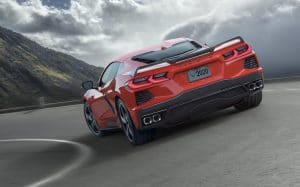
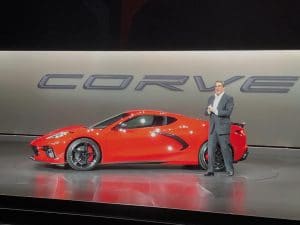
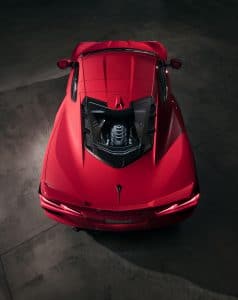
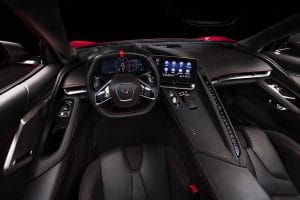
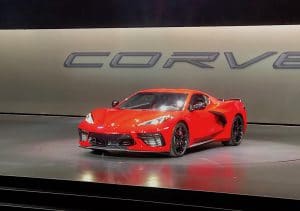
This article looked like a sales brochure, not a summary of an actual driving experience. I have owned several Corvettes and Proud owner, but believe me, they all have had negative problems that had to be felt with!
Michael, I pointed to a couple concerns, but a drive experience like we had was fairly limited in time and scope. As I also noted, we’ll be getting a longer run, with track time, in December. We should learn more about braking, handling, etc., at that point.
Paul E.
Paul, if you ever get your hands on one while visiting the Jersey Shore, don’t forget my address! BillyO
Absolutely, sir!